Anti-tank mine TM-35
The anti-tank mine TM-35 was put into service in 1935, and soon began to enter the engineering units of the Red Army. This product was devoid of some of the shortcomings of the previous T-4, which opened the way for the troops and allowed it to be actively used up to the 1941-42 years. The main reason for such success can be considered as a rather successful (in comparison with T-4) design, devoid of the drawbacks of the previous development. The T-4 operating experience was taken into account when creating a new weapon, which made it possible to get rid of some negative features. However, the new mine, as it turned out, was not without flaws.
The development of the industry allowed to equip the mine TM-35 with a metal case. It consisted of a main box and a lid of characteristic shape, which was a truncated pyramid. The body of the mine had dimensions of 23х22 cm, the total height with the lid installed was 8,5 cm. The design provided for the use of only one type of body, thanks to which all serial mines weighed about 5,2 kg. For convenience of carrying, a wire handle was provided on one of the case walls.
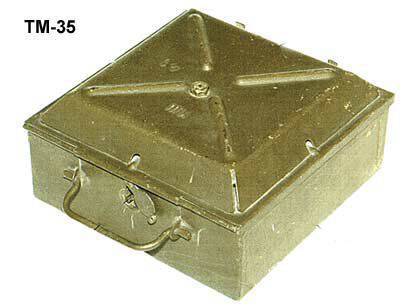
General view of the mines TM-35. Photo Saper.etel.ru
The TM-35 mine was a metal stamped box. On its walls there were protruding teeth, which were proposed to be used in the final assembly of the mine. The housing cover consisted of a curved top and a smooth inner sheet. On one side of the box and the lid, a loop was provided with which they were connected to each other. The loop made it possible to open the lid for final assembly of the mine before installation.
Near one of the walls of the case there was a box with the dimensions 10х2,5х5, see. A hole with a sliding cover was drilled in the case next to it. The inner end of the box had a hole for the installation of the fuse. The main charge of the mine was located around the box in the hull. The hull dimensions allowed the use of 6 explosive sacks weighing 400 g and 2 sacks weighing 200 g. Thus, the total charge of ammunition weighed 2,8 kg. If necessary, the mine could be filled with powdered explosive, but in this case no more than 2,4 kg of explosives were placed in the hull. Trotyl, ammotol, a French mixture or other available explosive could be used to hit a target.
Inside the box housing located fuse and related parts. The fuse MUV, connected to the capsule-detonator No. 8 (according to other data, the MD-2 fuse was used) was placed inside the mine through an opening in the front wall of the hull. In this case, the detonator cap passed through a hole in the inner wall of the case and was in contact with one of the explosives. Above the fuse was suspended on the axis of the lever of a curved shape, made of a flat metal plate. It was he who was responsible for triggering the fuse. In addition, in the middle part of the cover a special bolt was provided, which was in contact with the free (upper) arm of the lever.
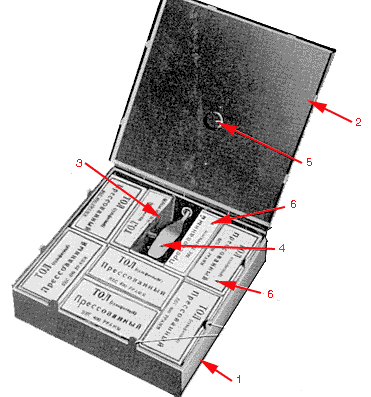
The overall layout of mines. Figure Saper.etel.ru
Fuse MVU had a fairly simple design. Inside the cylindrical body there was a mainspring and a drummer. The latter, in the cocked position, was pulled out of the case and fixed with a P-shaped check. For safe transportation used additional safety check. At the bottom of the fuse body there was a thread for installing the blasting cap. When removing the checks, the mainspring had to move the drummer and cause the pyrotechnic mixture of the primer to ignite.
Mines TM-35 were delivered to the troops disassembled. Empty hulls were transported separately from explosives and fuses. The final assembly of the mines was carried out by sappers before entering the combat mission. In preparing the mines for use, a set of eight checkers was inserted into the hull or a powdered explosive was poured. After that, the mine was ready for delivery to the installation site.
To install the TM-35 product, in addition to the MUV fuse and the No. XXNX detonator blaster, two special templates were required to check the status of various parts. One template was a long wooden bar, whose diameter coincided with the diameter of the fuse MCU. Such a template was used to check the location of the fuse and the blasting cap before installing them: it was used to check the correct mutual position of several parts, including the swinging lever and the checker socket in contact with the blasting cap.
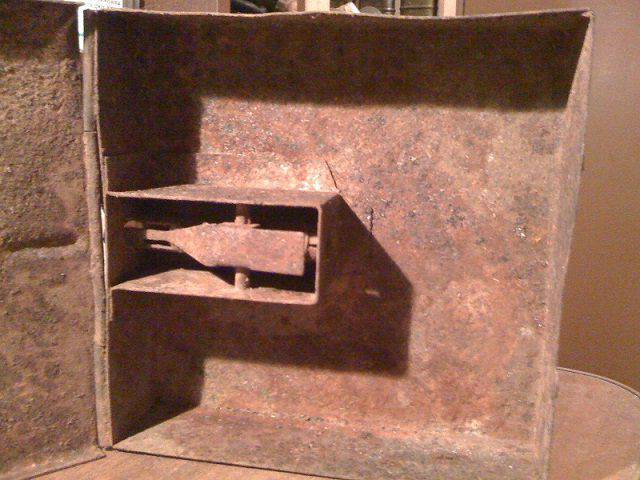
Housing mines, see the lever. Photo Dimon777 / Forum.guns.ru
The second pattern was a metal plate with a cutout of the desired size. During the installation of the mines should open the lid and check the position of the pressure bolt. He should not have protruded from the lower part of the cover more than a set distance. In the correct position, the lower part of the bolt could touch the free arm of the lever, but it should not have put pressure on it.
After checking all the elements of the mine, the sapper had to put the fuse in place without safety checks and the blasting cap. For this, the lid on the front wall of the mine was moved and the cylindrical parts were neatly inserted into the ammunition. During the installation of the fuse, the miner had to get the detonator cap into the hole in the rear wall of the inner box of the case, and also put the fuse combat checks ring on the pointed end of the lever arm. In its place, the fuse was fixed with a cap on the wall, returned to its place.
After installing all the necessary parts, you should carefully close the housing cover and secure it in its place. To hold the cover, several teeth were used on the upper face of the body, which were bent and meshed with the side surface of the cover.
A ready-to-use mine could be placed in a hole of appropriate size or placed on the ground surface. Also allowed to install in the snow.
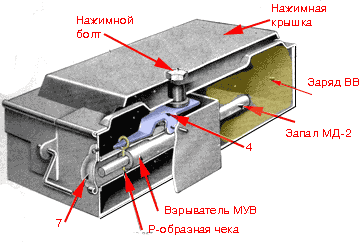
Incision of TM-35 mines. Figure Saper.etel.ru
By the principle of operation of the fuse, the TM-35 mine was little different from the previous T-4. In it, as before, a lever was used that connected the target sensor and the fuse. Undermining of a new model was to be carried out at a pressure on the upper part of the lid with dimensions 18х18 cm with a force of the order of 120-260 kg. At the same time, a deformation of the lid design occurred, as a result of which the pressure bolt was lowered and pressed on its lever arm. The second end of the lever had to pull out the fuse's check, freeing his drummer. After extracting the checks an explosion occurred.
The anti-tank mine TM-35 could have a charge weighing 2,4-2,8 kg. This made it possible to destroy vehicles or damage armored vehicles. The operation in the normal way under the people was excluded due to the relatively low sensitivity of the target sensor. However, over time, mines with a metal hull could become dangerous for humans. Any means that impeded the neutralization or made it impossible, were not provided. However, in this case, the mine could be a danger to the sappers.
The TM-35 product had a metal case, which affected its service life. In fact, such a mine could be in its place and wait for the enemy to appear for several months or years. However, the actual characteristics of the leaking ammunition depended on several factors. For example, a mine with TNT bones could remain operational for years or decades, while ammonite and other explosives would quickly melt and lose their properties.
It is also necessary to note the corrosive destruction of metal parts. The relatively high triggering force of the TM-35 mine was associated with the design of the cover. When the cover was damaged or destroyed, the force required to collapse it was noticeably reduced. Finally, one should not forget about the sufficiently sensitive MUV fuse: to extract the checks, an effort of no more than 1-3 kg was required. Thus, the TM-35 mine eventually became dangerous not only for equipment, but also for people.
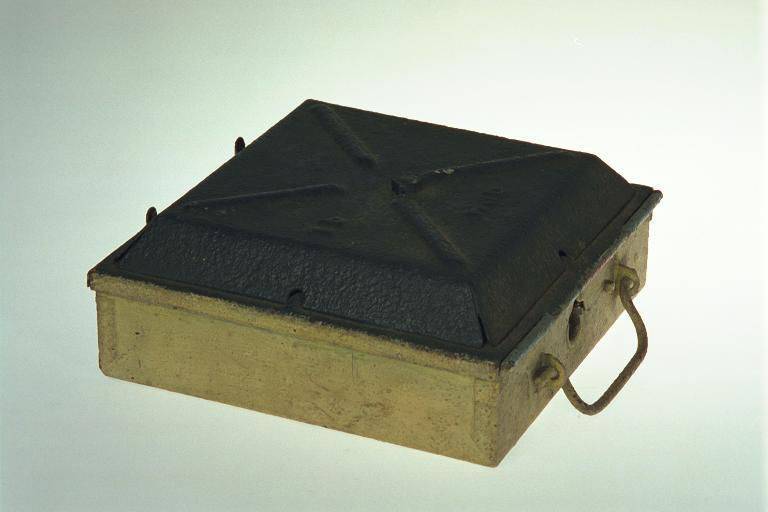
The body of the TM-35M mines. Photo Lexpev.nl
The anti-tank mines TM-35 produced in large batches for several years. In the course of mass production at various enterprises, various technological changes were introduced into the design of the munition. The characteristics of the mines remained at a given level. Production and supply of mines TM-35 in the base configuration lasted until the 1940 year. Soon after this, a new modification of the mine, called TM-35M, was developed and put into series.
The main difference between the modernized TM-35M and the basic TM-35 was the high case height. By increasing the overall height of the mine to 11,5 cm (while maintaining other sizes), it was possible to increase the volume of the hull. Increasing the height of the mines by only 3 cm allowed to increase the internal volume of the mines by 1,7 liters and increase the explosive charge to 4 kg. As before, the mine could be filled with TNT, ammotol, French mixture, etc. After the modifications, the total weight of the ammunition increased to 7 kg. Other characteristics remained unchanged.
The first armed conflict in which the TM-35 anti-tank mines were used was the Soviet-Finnish war. During this conflict, it was found that the available charge of no more than 2,8 kg does not always ensure defeat of the target. In addition, there were certain problems associated with the operation of metal products in a damp climate and in the autumn period.
However, the main problem of TM-35 was not associated with an insufficient charge or a body that is not resistant to corrosion. In practice, it turned out that the proposed method of equipment and the installation of mines seriously hampers the work of sappers. Thus, the need to equip the buildings with explosive swords led to a loss of time. The installation of mines was also a difficult and lengthy process. The rather complicated installation of the fuse did not allow mining in the vicinity of the leading edge or at night. The work of the sappers was also complicated by the high sensitivity of the MUV fuse and the need to install it with the extracted safety check.
Due to the existing problems, the TM-35 mines could be installed only during the day and only at some distance from the front edge. Thus, the quick and covert installation of minefields in dangerous areas was almost completely eliminated. As for the lack of power, the low weight of the mine’s own charge was usually compensated by laying additional explosives next to it.
The anti-tank mines TM-35 had insufficient performance and were difficult to handle. This was one of the reasons that their production ceased during the Soviet-Finnish war. Shortly thereafter, production of modernized TM-35M products was launched, however, in the new project only one problem was solved - insufficient charge weight.
From 1935 to 1940, the Soviet industry produced a fairly large number of mines TM-35, some of which were consumed during the war with Finland. However, after the end of this conflict, a large number of such weapons remained in stock. After the start of World War II mines began to be used again. Available stocks were enough to use before the start of the 1942 year. In addition, in parallel with the TM-35, advanced TM-35М were actively used.
Production of anti-tank mines TM-35M continued during the Great Patriotic War. Such weapons were actively used on all fronts, both independently and in parallel with other mines of similar purpose. With the advent of newer and improved mines, the TM-35M began to gradually go out of use. The latest ammunition of this type, according to various sources, was used in 1944-45. By this time, the Red Army already had anti-tank mines of new models, devoid of the shortcomings of the products of the TM-35 family.
On the materials of the sites:
http://saper.etel.ru/
http://lexpev.nl/
http://eragun.org/
http://jmu.edu/
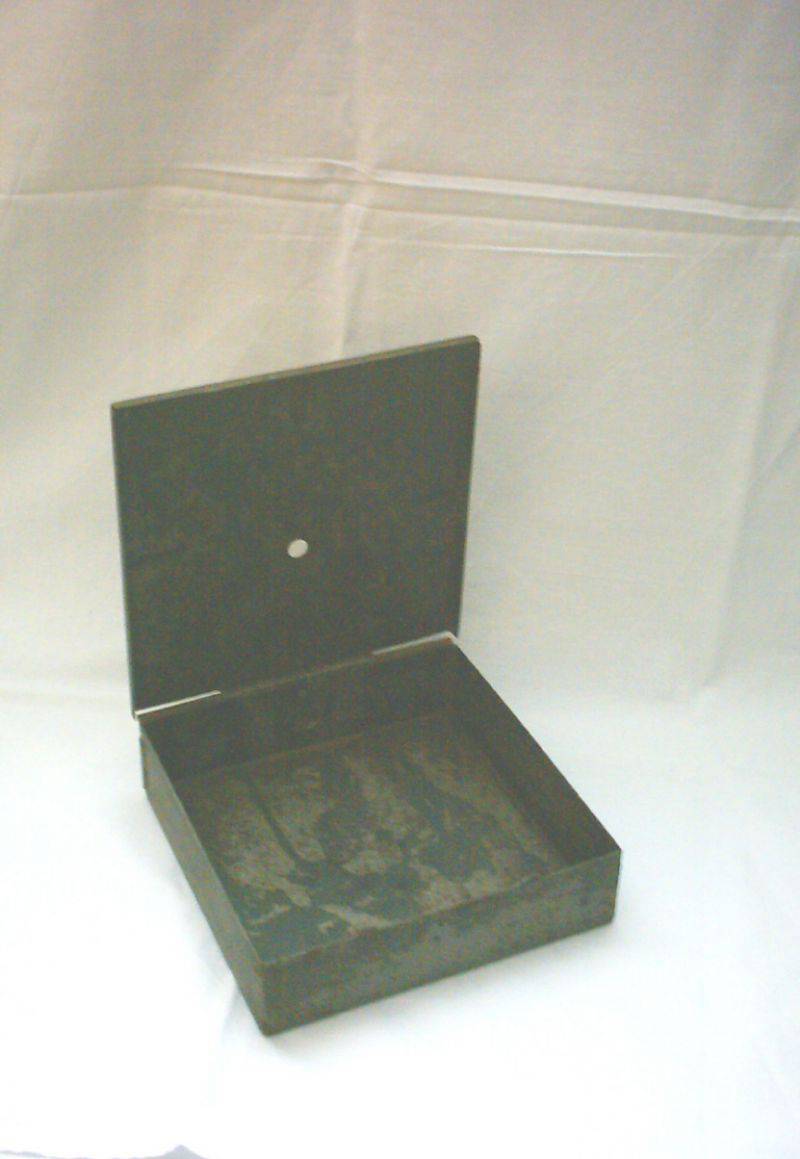
Information